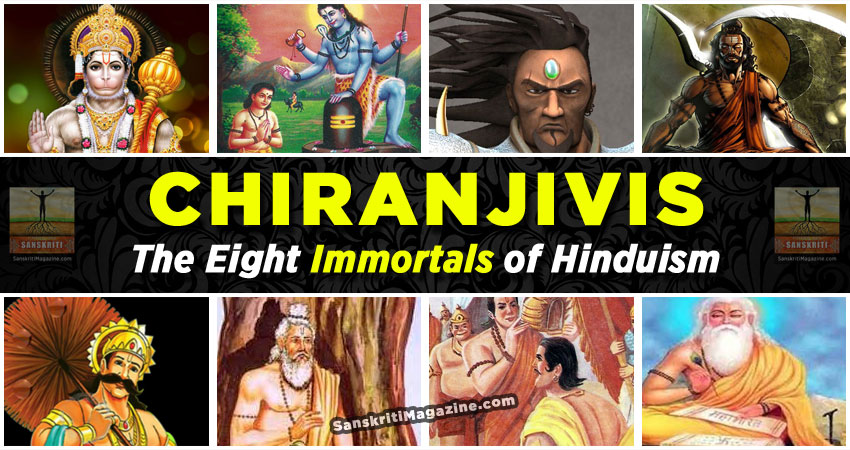Chiranjivi are permanent lived beings in Hinduism who are to remain alive through this Kali Yuga until the next Satya Yuga. The term is a combination of chiram, or ‘permanent’, and jīvi, or ‘lived’. It is same as’amaratva, which refers to true immortality.
At the end of the last Kalpa, a demon attempted to become immortal by swallowing the Vedas as they escaped from the mouth of Brahma. The scripture was retrieved by the first avatar of Vishnu, Matsya. Incarnations of Vishnu also later fought and killed two other asuras, Hiranyakasipu and Ravana, who tried to become immortal through obeisance to Shiva. In Hinduism, immortal does not mean eternal, as all physical bodies are foretold to become immaterial at the end of time, along with Brahma himself.
Puranas, the Mahabharata and the Ramayana describe eight long lived personalities in the Hindu pantheon. They existed in past ages, Satya Yuga, Treta Yuga, and Dvapara Yuga, and are alive today in our current Kali Yuga. Each represents a different attribute of man, which as long as they live, will exist amongst humanity.
The chiranjivi are as follows:
Markandeya
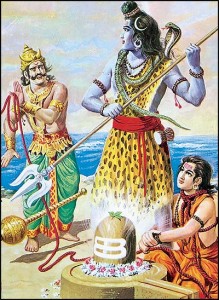 An ancient sage from the Hindu tradition, born in the clan of Brigu Rishi. He is celebrated as a devotee of both Shiva and Vishnu and is mentioned in a number of stories from the Puranas.
An ancient sage from the Hindu tradition, born in the clan of Brigu Rishi. He is celebrated as a devotee of both Shiva and Vishnu and is mentioned in a number of stories from the Puranas.
The Markandeya Purana especially, comprises a dialogue between Markandeya and a sage called Jaimini, and a number of chapters in the Bhagavata Purana are dedicated to his conversations and prayers. He is also mentioned in the Mahabharata. Markandeya is venerated within all mainstream Hindu traditions.
Mrikandu rishi and his wife Marudmati worshipped Shiva and sought from him the boon of begetting a son. As a result he was given the choice of either a gifted son, but with a short life on earth or a child of low intelligence but with a long life. Mrikandu rishi chose the former, and was blessed with Markandeya, an exemplary son, destined to die at the age of 12.
Markandeya grew up to be a great devotee of Shiva and on the day of his destined death he continued his worship of Shiva in his aniconic form of Shivalingam. The messengers of Yama, the god of death were unable to take away his life because of his great devotion and continual worship of Shiva. Yama then came in person to take away Markandeya’s life, and sprung his noose around the young sage’s neck. By accident or fate the noose mistakenly landed around the Shivalingam, and out of it, Shiva emerged in all his fury attacking Yama for his act of aggression. After defeating Yama in battle to the point of death, Shiva then revived him, under the condition that the devout youth would live forever. For this act, Shiva was thereafter known also as Kalantaka (“Ender of Death”).
Thus Maha Mrityunjaya Stotra is also attributed to Markandeya. The Devi Mahatmya section of the Markandeya Purana is one of the most important texts of Shakti tradition.
Ashwatthama
The son of Drona, a great warrior. He acted out of cowardice to avenge the killing of his father, resulting in a curse of immortality.
Since Hastinapur, ruled by King Dhrishtrastra, offered Dronacharya the privilege of teaching the Kuru princes, both Dronacharya and Ashwatthama were loyal to Hastinapur and fought for the Kauravas in the Kurukshetra war.
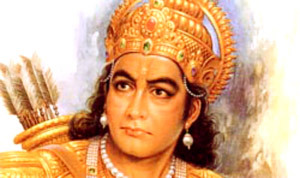 On the last night of the war after Duryodhana’s defeat, a very disturbed and restless Ashwatthama was sitting sleepless under a large tree. An owl caught his attention. He observed that an owl was being attacked and harassed by crows in the morning. This owl attacked the same group of crows at night. This gave him an idea of attacking the Pandava camp at midnight. He gathered the only other surviving Kaurava warriors—Kritavarma and Kripacharya and attacked the Pandava camp on the 18th night of the Kurukshetra war. He killed Dhrishtadyumna, Shikhandi and many other prominent warriors of Pandava army while they were sleeping. Those who tried to flee from Ashwatthama’s wrath, were hacked down by Kripacharyya and Kritavarma who were positioned at the camp’s entrance. He killed Draupadi’s five sons, the Upapandavas, while they were sleeping believing them to be the five Pandava brothers.
On the last night of the war after Duryodhana’s defeat, a very disturbed and restless Ashwatthama was sitting sleepless under a large tree. An owl caught his attention. He observed that an owl was being attacked and harassed by crows in the morning. This owl attacked the same group of crows at night. This gave him an idea of attacking the Pandava camp at midnight. He gathered the only other surviving Kaurava warriors—Kritavarma and Kripacharya and attacked the Pandava camp on the 18th night of the Kurukshetra war. He killed Dhrishtadyumna, Shikhandi and many other prominent warriors of Pandava army while they were sleeping. Those who tried to flee from Ashwatthama’s wrath, were hacked down by Kripacharyya and Kritavarma who were positioned at the camp’s entrance. He killed Draupadi’s five sons, the Upapandavas, while they were sleeping believing them to be the five Pandava brothers.
After destroying the entire Pandava camp, Ashwatthama carried the five heads of Draupadi’s sons and proceeded towards Duryodana claiming that he had beheaded the Pandavas. When he realized his mistake, Ashwatthama went to Sage Vedavyasa’s ashram in order to seek salvation for his crime.
The Pandavas and Krishna who were away during night, now returned to their camp the next day morning. Incensed over this cowardly act of Ashwatthama, the Pandavas went after him to sage Vyasa’s ashram. On seeing the approaching angered Pandavas, Ashwatthama who learnt that he had killed the upapandavas and not the Pandavas, realised that he was trapped with the Pandavas. As a last resort, he used his sacred knowledge of the Vedas to devise a Bramhashirastra from a blade of grass and invoked it against the Pandavas and Krishna, although he was strictly forbidden to do so by his father Dronacharya for any purpose whatsoever. On seeing the Brahmashirastra approaching the Pandavas, Krishna asked Arjuna to invoke the same. Arjuna invokes Bramhashirastra, which he received by Dronacharya himself, towards Ashwatthama.
On seeing the two powerful astras heading for a head on cataclysmic (catastrophic) collision that would result in the total annihilation of the entire Earth, sage Vyasa stopped these divine weapons from colliding with each other by using his yogic power. He asked both these warriors to withdraw their respective weapons. Arjuna was able to withdraw his Brahmashirastra, while Ashwatthama could not do so as Dronocharya did not teach his son how to withdraw it. An archer who is able to invoke and withdraw any Divyastra (Divine Weapon) can invoke it as many times as he wishes. Dronacharya taught Arjuna to withdraw Brahmashirastra but he did not do so to Ashwathama, thus limiting the power of Ashwathama to invoke Brahmashirastra for only one instance.
However, Ahswathama was given the option of deviating his weapon towards one single isolated object in a place that was not inhabited by any form of life, so that the Brahmashirastra does not harm anyone on Earth. But Ashwatthama, out of spite, directed the weapon towards the womb of Uttara (wife of Abhimanyu) who was carrying Abhimanyu’s son (Parikshit) in an attempt to end the lineage of the Pandavas. Krishna used his sudarshana chakra to stop the Brahmashirastra and save Uttara’s unborn child.
Angered by this cowardly act, Lord Krishna placed a curse on Ashwatthama that “he will carry the burden of all people’s sins on his shoulders and will roam alone like a ghost without getting any love and courtesy till the end of Kaliyuga; He will have neither any hospitality nor any accommodation; He will be in total isolation from mankind and society; His body will suffer from a host of incurable diseases forming sores and ulcers that would never heal”.
Ashwatthama had a gem which was similar to Shamantakamani on his forehead which used to protect the wearer from fear of any snakes, ghosts, demigods and demons. So, Ashwatthama was asked to surrender this gem. Lord Sri Krishna further states that “the wound caused by the removal of this gem on his forehead will never heal and will suffer from leprosy, till the end of Kaliyuga”. It is believed that in Kaliyuga, his name will be “Suryakanta”. Thus, Ashwatthama will be in search of death every moment, and yet he will never die. At the end of Kali Yuga, Ashwatthama is to meet Sri Kalki, the tenth and final avatar of Lord Vishnu.
Bali Chakravarthi
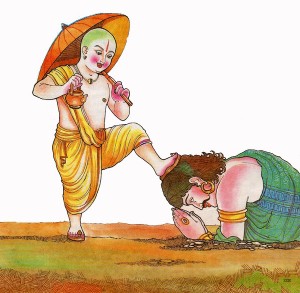 Granted a boon by Vishnu that he would be the next Indra, before merging with Vishnu, Bali expounds virtues of valour and charity.
Granted a boon by Vishnu that he would be the next Indra, before merging with Vishnu, Bali expounds virtues of valour and charity.
Bali, an asura, was the son of Devamba and Virochana. He grew up under the tutelage of his grandfather, Prahlada, who instilled in him a strong sense of righteousness and devotion. Bali would eventually succeed his grandfather as the king of the Asuras, and his reign over the realm was characterized by peace and prosperity. He would later expand his realm – bringing the entire world under his benevolent rule – and was even able to conquer the underworld and Heaven, which he wrested from Indra and the Devas. The Devas, after their defeat at the hands of Bali, approached Vishnu and entreated him to restore their lordship over Heaven.
In Heaven, Bali, on the advice of his guru and advisor, Sukracharya, had begun the Ashwamedha Yagya so as to maintain his rule over the three worlds. Vishnu, meanwhile, had adopted the avatar of Vamana, a small Brahmin boy, and, during the rite, approached Bali and requested a grant of land – although only as much land as he could cover with three paces. Despite the warnings of his advisor, Bali granted this boon. Vamana then grew to an immense size, and, with his first pace, traversed the all of the earth and the underworld. With his second pace, he covered Heaven in its entirety. Admitting defeat, and seeing that Vamana has no more room for his last step, Bali offered his own head as a stepping-stone. At this time the asuras spoke out in protest, but Bali silenced them. He explained that all living and non living things are of His creation, and so it was His right to have them back. Lord Vishnu, seeing the devotion of Mahabali, blessed him and raised to him to Suthala, the supreme position in heaven.
Hanuman
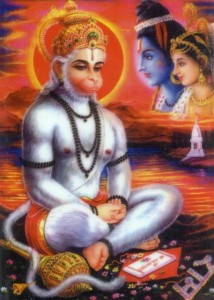 As an avatar of Shiva who served Rama, Hanuman stands for selflessness, courage, devotion, strength, and righteous conduct.
As an avatar of Shiva who served Rama, Hanuman stands for selflessness, courage, devotion, strength, and righteous conduct.
As an ardent devotee of Lord Rama, Hanuman is the central character in the Indian epic Ramayana. He also finds mentions in several other texts, including Mahabharata, the various Puranas and some Jain texts. A vanara (ape-like humanoid), Hanuman participated in Rama’s war against the demon king Ravana. Several texts also present him as an incarnation of Lord Shiva. He is also considered the son of Vayu, who according to several stories, played a role in his birth.
Shortly after he is crowned Emperor upon his return to Ayodhya, Rama decides to ceremoniously reward all his well-wishers. At a grand ceremony in his court, all his friends and allies take turns being honoured at the throne. Hanuman approaches without desiring a reward. Seeing Hanuman come up to him, an emotionally overwhelmed Rama embraces him warmly, declaring that he could never adequately honour or repay Hanuman for the help and services he received from the noble Vanara. Sita, however, insists that Hanuman deserved honour more than anyone else, and Sita gives him a necklace of precious stones adorning her neck.
When he receives it, Hanuman immediately takes it apart, and peers into each stone. Taken aback, many of those present demand to know why he is destroying the precious gift. Hanuman answers that he was looking into the stones to make sure that Rama and Sita are in them, because if they are not, the necklace is of no value to him. At this, a few mock Hanuman, saying his reverence and love for Rama and Sita could not possibly be as deep as he implies. In response, Hanuman tears his chest open, and everyone is stunned to see Rama and Sita literally in his heart.
After the war, and after reigning for several years, the time arrived for Rama to depart to his supreme abode Vaikuntha. Many of Rama’s entourage, including Sugriva, decided to depart with him. Hanuman, however, requested from Rama that he will remain on earth as long as Rama’s name was venerated by people. Sita accorded Hanuman that desire, and granted that his image would be installed at various public places, so he could listen to people chanting Rama’s name. He is one of the immortals (Chiranjivi) of Hinduism.
According to legend, Hanuman is one of the four people to have heard the Bhagwad Gita from Krishna and seen his Vishvarupa (universal) form, the other three being Arjuna, Sanjaya and Barbarika, son of Ghatotkacha.
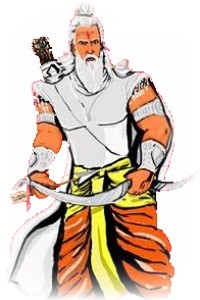 Kripa
Kripa
Also known as Kripacharya, he was military guru of the princes in the Mahabharata.
He fought in the great battle of Kurukshetra for the Kaurava side. Afterwards, he was appointed to be the teacher and preceptor of Parikshit, the grandson of Arjuna. He was known for his impartiality and loyalty for his Kingdom.
He is one of the immortals who are to remain alive throughout the present age, the Kali Yuga.
Parashurama
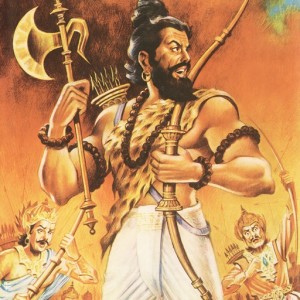 The 6th avatar of Vishnu, Parashurama was the master of all astras, sastras and divine weapons.
The 6th avatar of Vishnu, Parashurama was the master of all astras, sastras and divine weapons.
Parashurama is unique in that although he is the sixth avatar of Vishnu, as an immortal, he has also lived to see the subsequent incarnations of Vishnu in Rama, Krishna and Buddha. Parashurama played an important role in both the Ramayana and Mahabharata.
The Kalki Purana writes that he will re-emerge at end time to the martial guru of Kalki. He will then instruct the final avatar to undertake penance to receive celestial weaponry, required to save mankind at end time.
Vibhishana
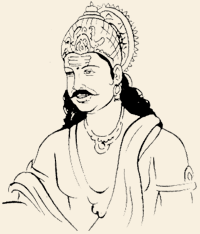 Younger half-brother of Ravana, though a Rakshasa himself, Vibhishana was of a noble character and advised Ravana, who kidnapped and abducted Sita, to return her to her husband Rama in an orderly fashion and promptly. When his brother did not listen to his advice, Vibhishana joined Rama’s army.
Younger half-brother of Ravana, though a Rakshasa himself, Vibhishana was of a noble character and advised Ravana, who kidnapped and abducted Sita, to return her to her husband Rama in an orderly fashion and promptly. When his brother did not listen to his advice, Vibhishana joined Rama’s army.
In the Lanka War, Vibhishana’s knowledge about the secrets of Lanka proved invaluable to Shri Rama. Vibhishana freely divulged many secrets that became key to the success of Rama’s attack, including revealing the secret path to the temple of Mata Nikumbala, the family deity of the Pulatsya Clan. Because of this, however, Vibhishana is also known as a traitor.
Later, he was crowned king of Lanka after Ravana was killed by Rama and turned his subjects from the path of evil to the path of Dharma (righteousness). He stands for righteousness. When Shri Rama was about to leave Ayodhya at the end of his reign, Lord Rama in his original form of Shri Vishnu ordered Vibhishana to stay on earth and serve the people and guide them to the path of truth and Dharma.
Vibhishana is not a true Chiranjeevi, as his boon of longevity is to remain on the earth only until the end of Treta Yuga.
Vyasa
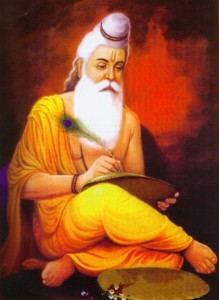 A sage who narrated the Mahabharata, he is also known as Veda Vyasa or Krishna Dvaipayana. He was the son of Rishi Prashar and grandson of Rishi Vashist, he represents erudition and wisdom. He is the author of the Mahabharata, as well as a character in it and is considered to be the scribe of both the Vedas and Puranas.
A sage who narrated the Mahabharata, he is also known as Veda Vyasa or Krishna Dvaipayana. He was the son of Rishi Prashar and grandson of Rishi Vashist, he represents erudition and wisdom. He is the author of the Mahabharata, as well as a character in it and is considered to be the scribe of both the Vedas and Puranas.
Vyasa’s Jaya, the core of Mahābhārata is structured in the form of a dialogue between Dhritarashtra (the Kuru king and the father of the Kauravas, who opposed the Pāndavas in the Kurukshetra War) and Sanjaya, his advisor and chariot driver. Sanjaya narrates each incident of the Kurukshetra War, fought in 18 days, as and when it happened. Dhritarāshtra sometimes asks questions and doubts and sometimes laments, knowing about the destruction caused by the war, to his sons, friends and kinsmen.
In the beginning Sanjaya gives a description of the various continents of the Earth, the other planets, and focuses on the Indian Subcontinent and gives an elaborate list of hundreds of kingdoms, tribes, provinces, cities, towns, villages, rivers, mountains, forests etc. of the (ancient) Indian Subcontinent (Bhārata Varsha). He also explains about the ‘military formations adopted by each side on each day, the death of each hero and the details of each war-racings.
Some 18 chapters of Vyasa’s Jaya constitute the Bhagavad Gita, the sacred text of the Hindus. Thus, this work of Vyasa, called Jaya deals with diverse subjects like geography, history, warfare, religion and morality.
The festival of Guru Purnima is dedicated to him. It is also known as Vyasa Purnima for it is the day believed to be both his birthday and the day he divided the Vedas into four parts.
Vyasa was born in almost last of Treta Yuga, lived to see the whole Dwapar Yuga and Kalyuga. Greatly disturbed by the violence in today’s world, he is said to have retreated from society into some remote village in Northern India.

